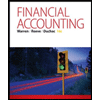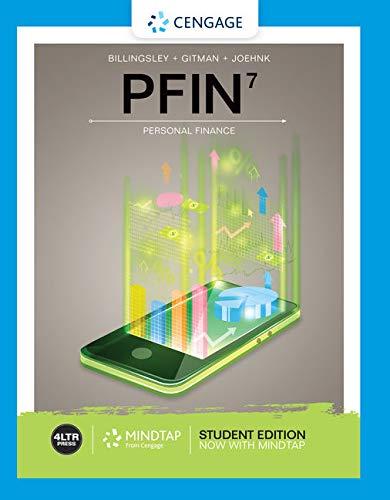
CORPORATE FINANCE--CONNECT ACCESS CARD
12th Edition
ISBN: 9781264807475
Author: Ross
Publisher: MCG CUSTOM
expand_more
expand_more
format_list_bulleted
Question
Chapter 9, Problem 20QAP
Summary Introduction
To calculate: The annual dividend, the closing price of the stock that appeared in yesterday’s newspaper, and the net income for the most recent four quarters.
Introduction: Annual dividend refers to the dividend paid on each share of a corporation for a single fiscal year or the total amount of dividends paid by the company during that year.
The closing price of the stock refers to a stock’s final price during a routine trading session.
For a given accounting period, an entity’s net income is its total revenue less its cost of goods sold, costs (expenses),
Expert Solution & Answer
Want to see the full answer?
Check out a sample textbook solution
Students have asked these similar questions
Dividend???
soln
Company a problem solve it
A proxy is an authorization that doesn’t allows one shareholder to vote on behalf of another shareholder.
TRUE OR FALSE
Chapter 9 Solutions
CORPORATE FINANCE--CONNECT ACCESS CARD
Ch. 9 - Stock Valuation Why does the value of a share of...Ch. 9 - Stock Valuation A substantial percentage of the...Ch. 9 - Dividend Policy Referring to the previous...Ch. 9 - Prob. 4CQCh. 9 - Common versus Preferred Stock Suppose a company...Ch. 9 - Dividend Growth Model Based on the dividend growth...Ch. 9 - Growth Rate In the context of the dividend growth...Ch. 9 - Price-Earnings Ratio What are the three factors...Ch. 9 - Prob. 9CQCh. 9 - Prob. 10CQ
Ch. 9 - Prob. 1QAPCh. 9 - Stock Values The next dividend payment by Skippy,...Ch. 9 - Prob. 3QAPCh. 9 - Stock Values Saine Corporation will pay a 3.25 per...Ch. 9 - Stock Valuation Change, Inc., is expected to...Ch. 9 - Stock Valuation Suppose you know that a companys...Ch. 9 - Prob. 7QAPCh. 9 - Prob. 8QAPCh. 9 - Growth Rate The newspaper reported last week that...Ch. 9 - Prob. 10QAPCh. 9 - Prob. 11QAPCh. 9 - Prob. 12QAPCh. 9 - Prob. 13QAPCh. 9 - Prob. 14QAPCh. 9 - Prob. 15QAPCh. 9 - Prob. 16QAPCh. 9 - Prob. 17QAPCh. 9 - Prob. 18QAPCh. 9 - Valuing Preferred Stock Fifth National Bank just...Ch. 9 - Prob. 20QAPCh. 9 - Nonconstant Growth and Quarterly Dividends...Ch. 9 - Finding the Dividend Newkirk, Inc., is expected to...Ch. 9 - Prob. 23QAPCh. 9 - Prob. 24QAPCh. 9 - Price-Earnings Ratio Consider Pacific Energy...Ch. 9 - Prob. 26QAPCh. 9 - Stock Valuation and EV FFDP Corp. has yearly sales...Ch. 9 - Stock Valuation and Cash Flows Full Boat...Ch. 9 - Prob. 29QAPCh. 9 - Prob. 30QAPCh. 9 - Nonconstant Growth Storico Co. just paid a...Ch. 9 - Prob. 32QAPCh. 9 - Prob. 1MCCh. 9 - Prob. 2MCCh. 9 - Prob. 3MCCh. 9 - Prob. 4MCCh. 9 - Prob. 5MCCh. 9 - Prob. 6MC
Knowledge Booster
Similar questions
- Calculate Value of R??arrow_forwardHello tutor need barrow_forwardMoose Enterprises finds it is necessary to determine its marginal cost of capital. Moose’s current capital structure calls for 50 percent debt, 30 percent preferred stock, and 20 percent common equity. Initially, common equity will be in the form of retained earnings (Ke) and then new common stock (Kn). The costs of the various sources of financing are as follows: debt, 9.6 percent; preferred stock, 9 percent; retained earnings, 10 percent; and new common stock, 11.2 percent. a. What is the initial weighted average cost of capital? (Include debt, preferred stock, and common equity in the form of retained earnings, Ke.) b. If the firm has $18 million in retained earnings, at what size capital structure will the firm run out of retained earnings? c. What will the marginal cost of capital be immediately after that point? (Equity will remain at 20 percent of the capital structure, but will all be in the form of new common stock, Kn.) d. The 9.6 percent cost of debt referred to earlier…arrow_forward
- 7. Berkeley Farms wants to determine the minimum cost of capital point for the firm. Assume it is considering the following financial plans: Cost (aftertax) Weights Plan A Debt .................................. 4.0% 30% Preferred stock .................. 8.0 15 Common equity ................. 12.0 55 Plan B Debt .................................. 4.5% 40% Preferred stock .................. 8.5 15 Common equity ................. 13.0 45 Plan C Debt .................................. 5.0% 45% Preferred stock .................. 18.7 15 Common equity ................. 12.8 40 Plan D Debt .................................. 12.0% 50% Preferred stock .................. 19.2 15 Common equity ................. 14.5 35 a. Which of the four plans has the lowest weighted average cost of capital? Use the Kd (cost of debt) = Y(1 - T), Kp (Cost of preferred stock) = Dp/Pp - F, Ke = D1/P0 + g formulas or I will not understand.arrow_forwardNeed use the Kd (cost of debt) = Y(1 - T), Kp (Cost of preferred stock) = Dp/Pp - F, Ke = D1/P0 + g formulas or I will not understand. Delta Corporation has the following capital structure: Cost Weighted (after-tax) Weights Cost Debt 8.1% 35% 2.84% Preferred stock (Kp) 9.6 5 .48 Common equity (Ke) (retained earnings) 10.1 60 6.06 Weighted average cost of capital (Ka) 9.38% a. If the firm has $18…arrow_forwardDelta Corporation has the following capital structure: Cost Weighted (after-tax) Weights Cost Debt 8.1% 35% 2.84% Preferred stock (Kp) 9.6 5 .48 Common equity (Ke) (retained earnings) 10.1 60 6.06 Weighted average cost of capital (Ka) 9.38% a. If the firm has $18 million in retained earnings, at what size capital structure will the firm run out of retained earnings? b. The 8.1 percent cost of…arrow_forward
- Dillon Enterprises has the following capDillon Enterprises has the following capital structure. Debt ........................ 40% Common equity ....... 60 The after-tax cost of debt is 6 percent, and the cost of common equity (in the form of retained earnings) is 13 percent. What is the firm’s weighted average cost of capital? a. An outside consultant has suggested that because debt is cheaper than equity, the firm should switch to a capital structure that is 50 percent debt and 50 percent equity. Under this new and more debt-oriented arrangement, the after-tax cost of debt is 7 percent, and the cost of common equity (in the form of retained earnings) is 15 percent. Recalculate the firm’s weighted average cost of capital. b. Which plan is optimal in terms of minimizing the weighted average cost of capital?arrow_forwardCompute Ke and Kn under the following circumstances: a. D1= $5, P0=$70, g=8%, F=$7 b. D1=$0.22, P0=$28, g=7%, F=2.50 c. E1 (earnings at the end of period one) = $7, payout ratio equals 40 percent, P0= $30, g=6%, F=$2,20. Note: D1 is the earnings times the payout rate. d. D0 (dividend at the beginning of the first period) = $6, growth rate for dividends and earnings (g)=7%, P0=$60, F=$3. You will need to calculate D1 (the dividend after the first period).arrow_forwardTerrier Company is in a 45 percent tax bracket and has a bond outstanding that yields 11 percent to maturity. a. What is Terrier's after-tax cost of debt? b. Assume that the yield on the bond goes down by 1 percentage point, and due to tax reform, the corporate tax falls to 30 percent. What is Terrier's new aftertax cost of debt? c. Has the after-tax cost of debt gone up or down from part a to part b? Explain why.arrow_forward
arrow_back_ios
SEE MORE QUESTIONS
arrow_forward_ios
Recommended textbooks for you
 Managerial AccountingAccountingISBN:9781337912020Author:Carl Warren, Ph.d. Cma William B. TaylerPublisher:South-Western College Pub
Managerial AccountingAccountingISBN:9781337912020Author:Carl Warren, Ph.d. Cma William B. TaylerPublisher:South-Western College Pub Financial AccountingAccountingISBN:9781305088436Author:Carl Warren, Jim Reeve, Jonathan DuchacPublisher:Cengage Learning
Financial AccountingAccountingISBN:9781305088436Author:Carl Warren, Jim Reeve, Jonathan DuchacPublisher:Cengage Learning Pfin (with Mindtap, 1 Term Printed Access Card) (...FinanceISBN:9780357033609Author:Randall Billingsley, Lawrence J. Gitman, Michael D. JoehnkPublisher:Cengage Learning
Pfin (with Mindtap, 1 Term Printed Access Card) (...FinanceISBN:9780357033609Author:Randall Billingsley, Lawrence J. Gitman, Michael D. JoehnkPublisher:Cengage Learning

Managerial Accounting
Accounting
ISBN:9781337912020
Author:Carl Warren, Ph.d. Cma William B. Tayler
Publisher:South-Western College Pub

Financial Accounting
Accounting
ISBN:9781305088436
Author:Carl Warren, Jim Reeve, Jonathan Duchac
Publisher:Cengage Learning

Pfin (with Mindtap, 1 Term Printed Access Card) (...
Finance
ISBN:9780357033609
Author:Randall Billingsley, Lawrence J. Gitman, Michael D. Joehnk
Publisher:Cengage Learning